Comprehensive Essay on the Development and Evolution of Terrorism
VerifiedAdded on 2023/01/17
|5
|1433
|49
Essay
AI Summary
This essay provides an in-depth analysis of the evolution of terrorism, tracing its origins back to the French Revolution and exploring its multifaceted definitions. It examines the shift from state-sponsored terrorism to acts targeting states, emphasizing the social and political constructs that shape terrorist behavior. The essay delves into contributory factors such as government support, ideologies, social intolerance, technological advancements, and the impact of technology. It highlights how these elements have fueled the growth and expansion of terrorism, offering insights into its complex dynamics and implications. The essay utilizes various scholarly sources to support its arguments and provide a comprehensive understanding of the subject.
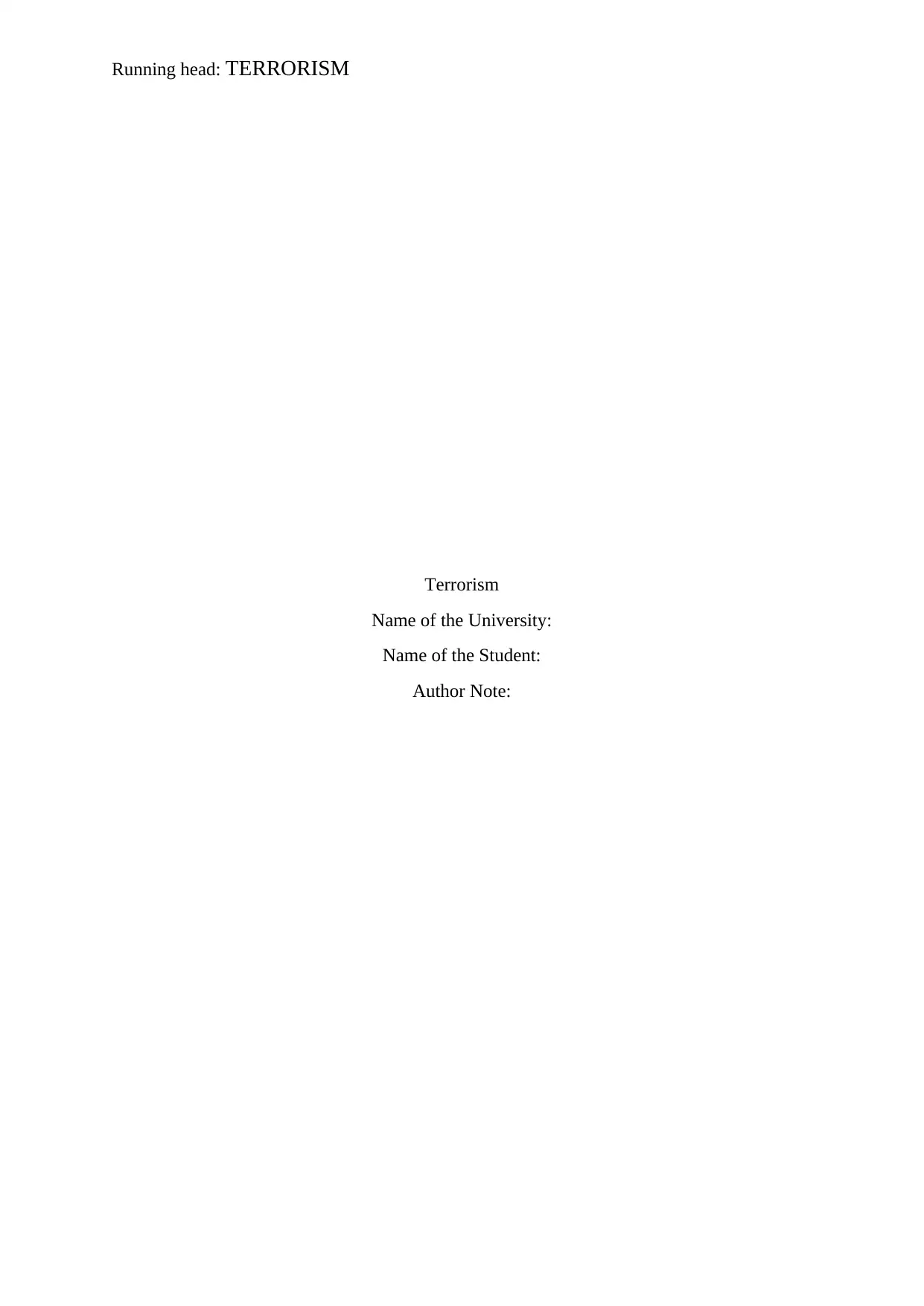
Running head: TERRORISM
Terrorism
Name of the University:
Name of the Student:
Author Note:
Terrorism
Name of the University:
Name of the Student:
Author Note:
Paraphrase This Document
Need a fresh take? Get an instant paraphrase of this document with our AI Paraphraser
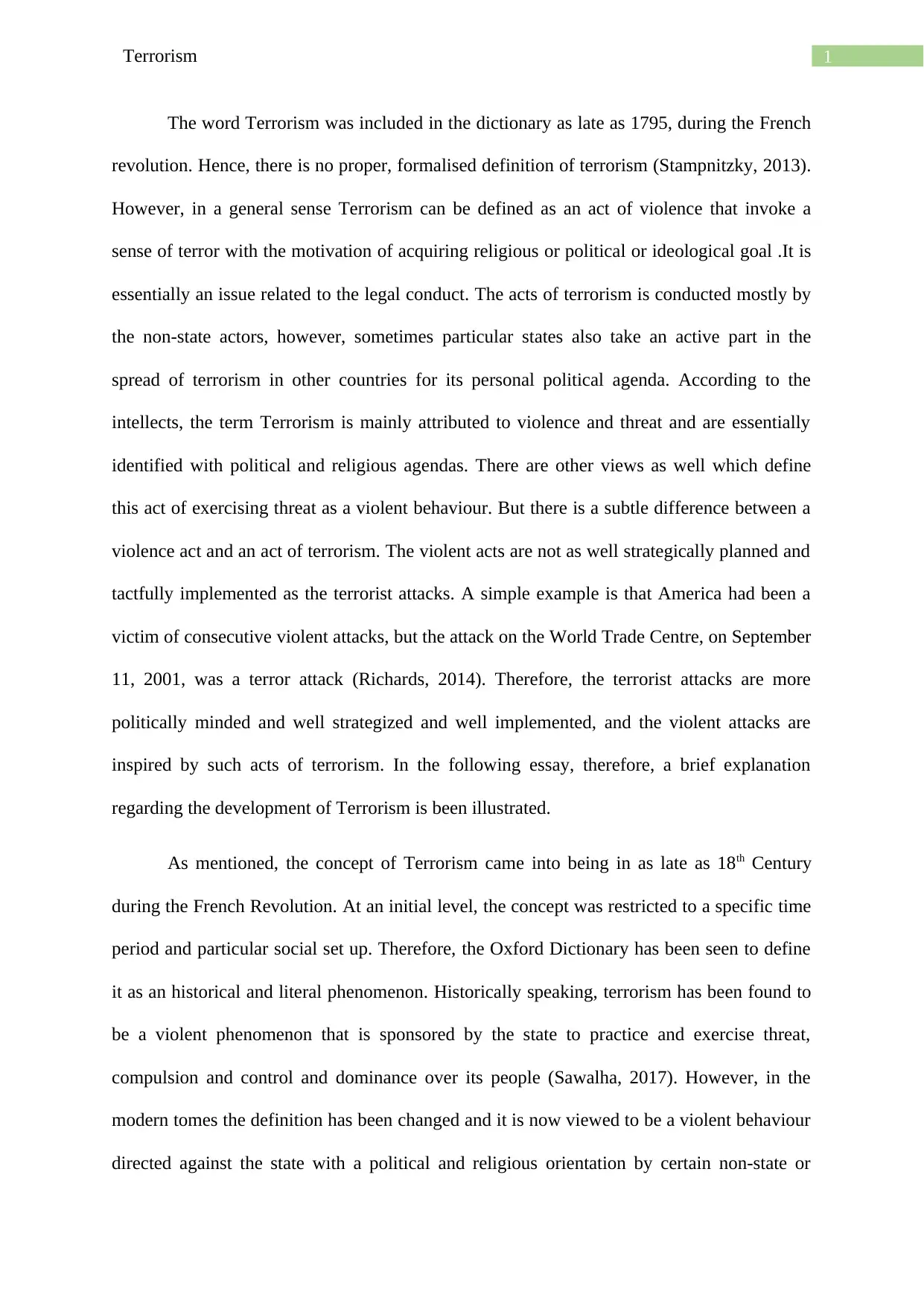
1Terrorism
The word Terrorism was included in the dictionary as late as 1795, during the French
revolution. Hence, there is no proper, formalised definition of terrorism (Stampnitzky, 2013).
However, in a general sense Terrorism can be defined as an act of violence that invoke a
sense of terror with the motivation of acquiring religious or political or ideological goal .It is
essentially an issue related to the legal conduct. The acts of terrorism is conducted mostly by
the non-state actors, however, sometimes particular states also take an active part in the
spread of terrorism in other countries for its personal political agenda. According to the
intellects, the term Terrorism is mainly attributed to violence and threat and are essentially
identified with political and religious agendas. There are other views as well which define
this act of exercising threat as a violent behaviour. But there is a subtle difference between a
violence act and an act of terrorism. The violent acts are not as well strategically planned and
tactfully implemented as the terrorist attacks. A simple example is that America had been a
victim of consecutive violent attacks, but the attack on the World Trade Centre, on September
11, 2001, was a terror attack (Richards, 2014). Therefore, the terrorist attacks are more
politically minded and well strategized and well implemented, and the violent attacks are
inspired by such acts of terrorism. In the following essay, therefore, a brief explanation
regarding the development of Terrorism is been illustrated.
As mentioned, the concept of Terrorism came into being in as late as 18th Century
during the French Revolution. At an initial level, the concept was restricted to a specific time
period and particular social set up. Therefore, the Oxford Dictionary has been seen to define
it as an historical and literal phenomenon. Historically speaking, terrorism has been found to
be a violent phenomenon that is sponsored by the state to practice and exercise threat,
compulsion and control and dominance over its people (Sawalha, 2017). However, in the
modern tomes the definition has been changed and it is now viewed to be a violent behaviour
directed against the state with a political and religious orientation by certain non-state or
The word Terrorism was included in the dictionary as late as 1795, during the French
revolution. Hence, there is no proper, formalised definition of terrorism (Stampnitzky, 2013).
However, in a general sense Terrorism can be defined as an act of violence that invoke a
sense of terror with the motivation of acquiring religious or political or ideological goal .It is
essentially an issue related to the legal conduct. The acts of terrorism is conducted mostly by
the non-state actors, however, sometimes particular states also take an active part in the
spread of terrorism in other countries for its personal political agenda. According to the
intellects, the term Terrorism is mainly attributed to violence and threat and are essentially
identified with political and religious agendas. There are other views as well which define
this act of exercising threat as a violent behaviour. But there is a subtle difference between a
violence act and an act of terrorism. The violent acts are not as well strategically planned and
tactfully implemented as the terrorist attacks. A simple example is that America had been a
victim of consecutive violent attacks, but the attack on the World Trade Centre, on September
11, 2001, was a terror attack (Richards, 2014). Therefore, the terrorist attacks are more
politically minded and well strategized and well implemented, and the violent attacks are
inspired by such acts of terrorism. In the following essay, therefore, a brief explanation
regarding the development of Terrorism is been illustrated.
As mentioned, the concept of Terrorism came into being in as late as 18th Century
during the French Revolution. At an initial level, the concept was restricted to a specific time
period and particular social set up. Therefore, the Oxford Dictionary has been seen to define
it as an historical and literal phenomenon. Historically speaking, terrorism has been found to
be a violent phenomenon that is sponsored by the state to practice and exercise threat,
compulsion and control and dominance over its people (Sawalha, 2017). However, in the
modern tomes the definition has been changed and it is now viewed to be a violent behaviour
directed against the state with a political and religious orientation by certain non-state or
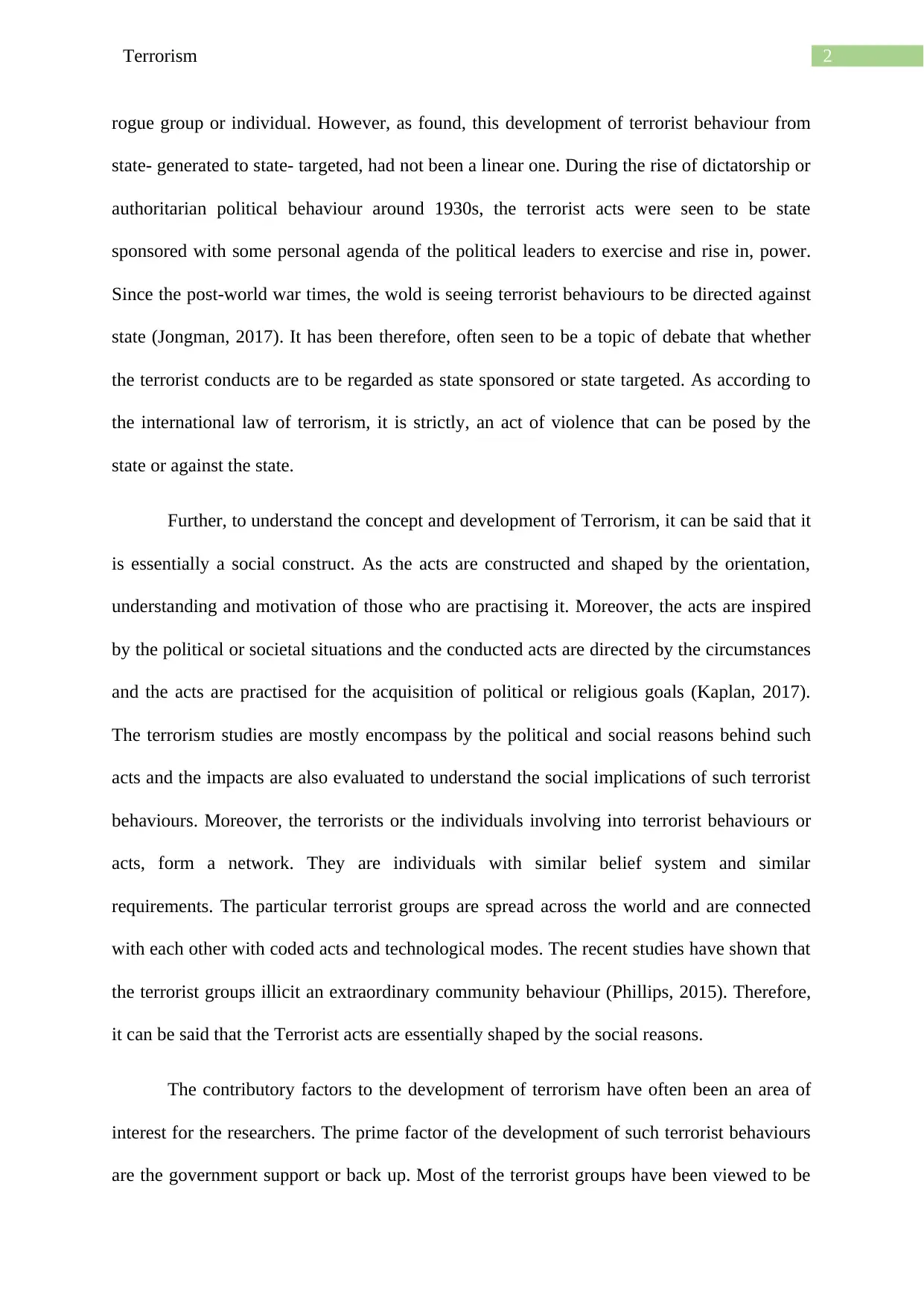
2Terrorism
rogue group or individual. However, as found, this development of terrorist behaviour from
state- generated to state- targeted, had not been a linear one. During the rise of dictatorship or
authoritarian political behaviour around 1930s, the terrorist acts were seen to be state
sponsored with some personal agenda of the political leaders to exercise and rise in, power.
Since the post-world war times, the wold is seeing terrorist behaviours to be directed against
state (Jongman, 2017). It has been therefore, often seen to be a topic of debate that whether
the terrorist conducts are to be regarded as state sponsored or state targeted. As according to
the international law of terrorism, it is strictly, an act of violence that can be posed by the
state or against the state.
Further, to understand the concept and development of Terrorism, it can be said that it
is essentially a social construct. As the acts are constructed and shaped by the orientation,
understanding and motivation of those who are practising it. Moreover, the acts are inspired
by the political or societal situations and the conducted acts are directed by the circumstances
and the acts are practised for the acquisition of political or religious goals (Kaplan, 2017).
The terrorism studies are mostly encompass by the political and social reasons behind such
acts and the impacts are also evaluated to understand the social implications of such terrorist
behaviours. Moreover, the terrorists or the individuals involving into terrorist behaviours or
acts, form a network. They are individuals with similar belief system and similar
requirements. The particular terrorist groups are spread across the world and are connected
with each other with coded acts and technological modes. The recent studies have shown that
the terrorist groups illicit an extraordinary community behaviour (Phillips, 2015). Therefore,
it can be said that the Terrorist acts are essentially shaped by the social reasons.
The contributory factors to the development of terrorism have often been an area of
interest for the researchers. The prime factor of the development of such terrorist behaviours
are the government support or back up. Most of the terrorist groups have been viewed to be
rogue group or individual. However, as found, this development of terrorist behaviour from
state- generated to state- targeted, had not been a linear one. During the rise of dictatorship or
authoritarian political behaviour around 1930s, the terrorist acts were seen to be state
sponsored with some personal agenda of the political leaders to exercise and rise in, power.
Since the post-world war times, the wold is seeing terrorist behaviours to be directed against
state (Jongman, 2017). It has been therefore, often seen to be a topic of debate that whether
the terrorist conducts are to be regarded as state sponsored or state targeted. As according to
the international law of terrorism, it is strictly, an act of violence that can be posed by the
state or against the state.
Further, to understand the concept and development of Terrorism, it can be said that it
is essentially a social construct. As the acts are constructed and shaped by the orientation,
understanding and motivation of those who are practising it. Moreover, the acts are inspired
by the political or societal situations and the conducted acts are directed by the circumstances
and the acts are practised for the acquisition of political or religious goals (Kaplan, 2017).
The terrorism studies are mostly encompass by the political and social reasons behind such
acts and the impacts are also evaluated to understand the social implications of such terrorist
behaviours. Moreover, the terrorists or the individuals involving into terrorist behaviours or
acts, form a network. They are individuals with similar belief system and similar
requirements. The particular terrorist groups are spread across the world and are connected
with each other with coded acts and technological modes. The recent studies have shown that
the terrorist groups illicit an extraordinary community behaviour (Phillips, 2015). Therefore,
it can be said that the Terrorist acts are essentially shaped by the social reasons.
The contributory factors to the development of terrorism have often been an area of
interest for the researchers. The prime factor of the development of such terrorist behaviours
are the government support or back up. Most of the terrorist groups have been viewed to be
⊘ This is a preview!⊘
Do you want full access?
Subscribe today to unlock all pages.

Trusted by 1+ million students worldwide
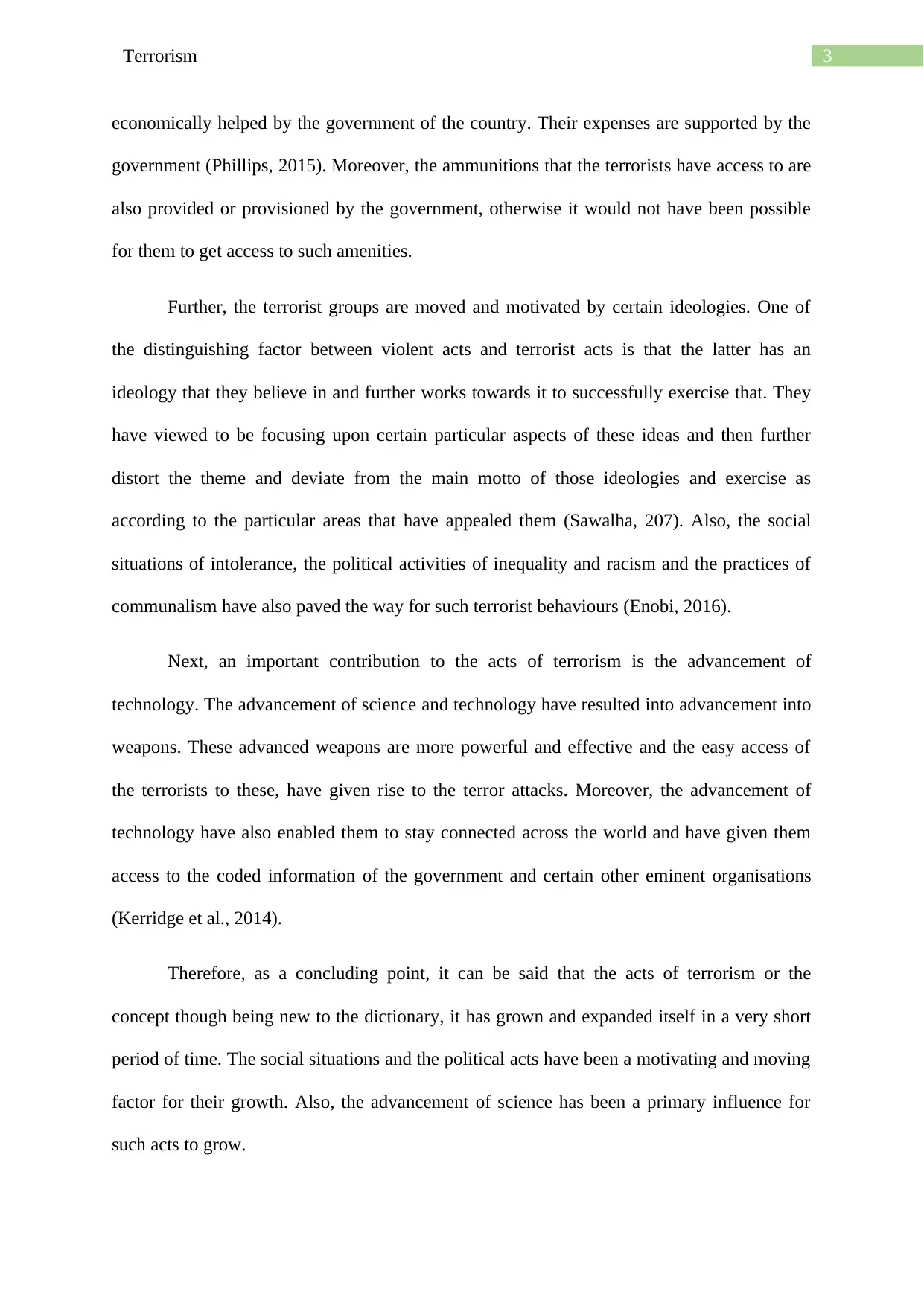
3Terrorism
economically helped by the government of the country. Their expenses are supported by the
government (Phillips, 2015). Moreover, the ammunitions that the terrorists have access to are
also provided or provisioned by the government, otherwise it would not have been possible
for them to get access to such amenities.
Further, the terrorist groups are moved and motivated by certain ideologies. One of
the distinguishing factor between violent acts and terrorist acts is that the latter has an
ideology that they believe in and further works towards it to successfully exercise that. They
have viewed to be focusing upon certain particular aspects of these ideas and then further
distort the theme and deviate from the main motto of those ideologies and exercise as
according to the particular areas that have appealed them (Sawalha, 207). Also, the social
situations of intolerance, the political activities of inequality and racism and the practices of
communalism have also paved the way for such terrorist behaviours (Enobi, 2016).
Next, an important contribution to the acts of terrorism is the advancement of
technology. The advancement of science and technology have resulted into advancement into
weapons. These advanced weapons are more powerful and effective and the easy access of
the terrorists to these, have given rise to the terror attacks. Moreover, the advancement of
technology have also enabled them to stay connected across the world and have given them
access to the coded information of the government and certain other eminent organisations
(Kerridge et al., 2014).
Therefore, as a concluding point, it can be said that the acts of terrorism or the
concept though being new to the dictionary, it has grown and expanded itself in a very short
period of time. The social situations and the political acts have been a motivating and moving
factor for their growth. Also, the advancement of science has been a primary influence for
such acts to grow.
economically helped by the government of the country. Their expenses are supported by the
government (Phillips, 2015). Moreover, the ammunitions that the terrorists have access to are
also provided or provisioned by the government, otherwise it would not have been possible
for them to get access to such amenities.
Further, the terrorist groups are moved and motivated by certain ideologies. One of
the distinguishing factor between violent acts and terrorist acts is that the latter has an
ideology that they believe in and further works towards it to successfully exercise that. They
have viewed to be focusing upon certain particular aspects of these ideas and then further
distort the theme and deviate from the main motto of those ideologies and exercise as
according to the particular areas that have appealed them (Sawalha, 207). Also, the social
situations of intolerance, the political activities of inequality and racism and the practices of
communalism have also paved the way for such terrorist behaviours (Enobi, 2016).
Next, an important contribution to the acts of terrorism is the advancement of
technology. The advancement of science and technology have resulted into advancement into
weapons. These advanced weapons are more powerful and effective and the easy access of
the terrorists to these, have given rise to the terror attacks. Moreover, the advancement of
technology have also enabled them to stay connected across the world and have given them
access to the coded information of the government and certain other eminent organisations
(Kerridge et al., 2014).
Therefore, as a concluding point, it can be said that the acts of terrorism or the
concept though being new to the dictionary, it has grown and expanded itself in a very short
period of time. The social situations and the political acts have been a motivating and moving
factor for their growth. Also, the advancement of science has been a primary influence for
such acts to grow.
Paraphrase This Document
Need a fresh take? Get an instant paraphrase of this document with our AI Paraphraser
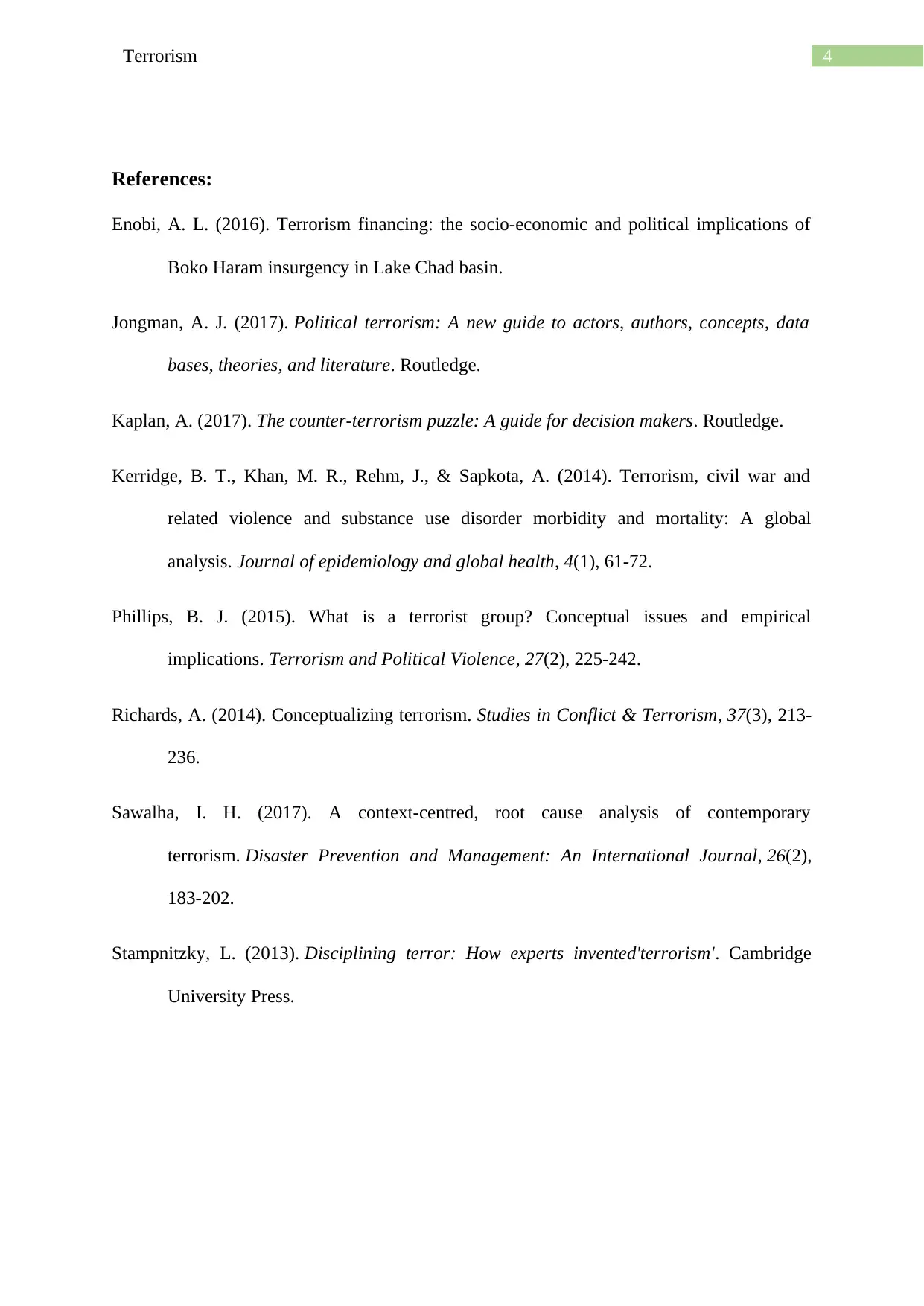
4Terrorism
References:
Enobi, A. L. (2016). Terrorism financing: the socio-economic and political implications of
Boko Haram insurgency in Lake Chad basin.
Jongman, A. J. (2017). Political terrorism: A new guide to actors, authors, concepts, data
bases, theories, and literature. Routledge.
Kaplan, A. (2017). The counter-terrorism puzzle: A guide for decision makers. Routledge.
Kerridge, B. T., Khan, M. R., Rehm, J., & Sapkota, A. (2014). Terrorism, civil war and
related violence and substance use disorder morbidity and mortality: A global
analysis. Journal of epidemiology and global health, 4(1), 61-72.
Phillips, B. J. (2015). What is a terrorist group? Conceptual issues and empirical
implications. Terrorism and Political Violence, 27(2), 225-242.
Richards, A. (2014). Conceptualizing terrorism. Studies in Conflict & Terrorism, 37(3), 213-
236.
Sawalha, I. H. (2017). A context-centred, root cause analysis of contemporary
terrorism. Disaster Prevention and Management: An International Journal, 26(2),
183-202.
Stampnitzky, L. (2013). Disciplining terror: How experts invented'terrorism'. Cambridge
University Press.
References:
Enobi, A. L. (2016). Terrorism financing: the socio-economic and political implications of
Boko Haram insurgency in Lake Chad basin.
Jongman, A. J. (2017). Political terrorism: A new guide to actors, authors, concepts, data
bases, theories, and literature. Routledge.
Kaplan, A. (2017). The counter-terrorism puzzle: A guide for decision makers. Routledge.
Kerridge, B. T., Khan, M. R., Rehm, J., & Sapkota, A. (2014). Terrorism, civil war and
related violence and substance use disorder morbidity and mortality: A global
analysis. Journal of epidemiology and global health, 4(1), 61-72.
Phillips, B. J. (2015). What is a terrorist group? Conceptual issues and empirical
implications. Terrorism and Political Violence, 27(2), 225-242.
Richards, A. (2014). Conceptualizing terrorism. Studies in Conflict & Terrorism, 37(3), 213-
236.
Sawalha, I. H. (2017). A context-centred, root cause analysis of contemporary
terrorism. Disaster Prevention and Management: An International Journal, 26(2),
183-202.
Stampnitzky, L. (2013). Disciplining terror: How experts invented'terrorism'. Cambridge
University Press.
1 out of 5
Related Documents
Your All-in-One AI-Powered Toolkit for Academic Success.
+13062052269
info@desklib.com
Available 24*7 on WhatsApp / Email
![[object Object]](/_next/static/media/star-bottom.7253800d.svg)
Unlock your academic potential
Copyright © 2020–2025 A2Z Services. All Rights Reserved. Developed and managed by ZUCOL.





